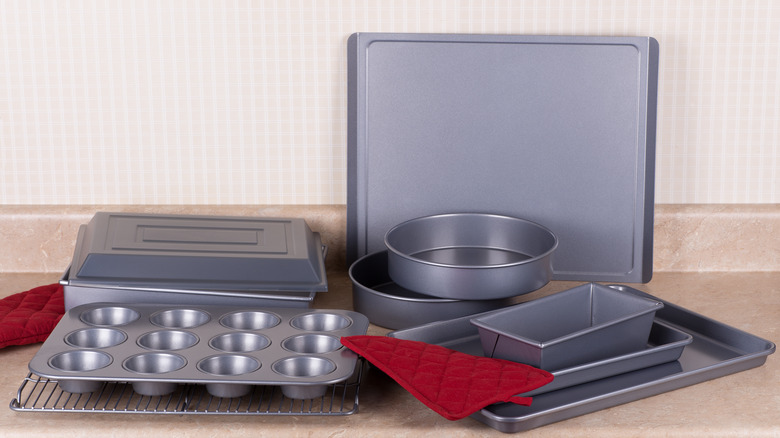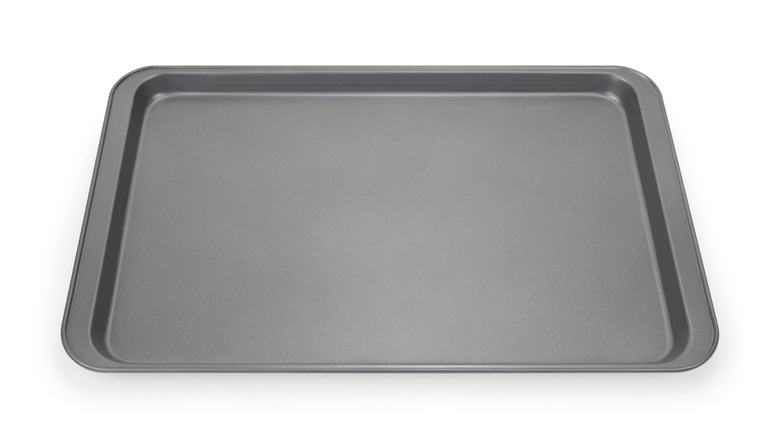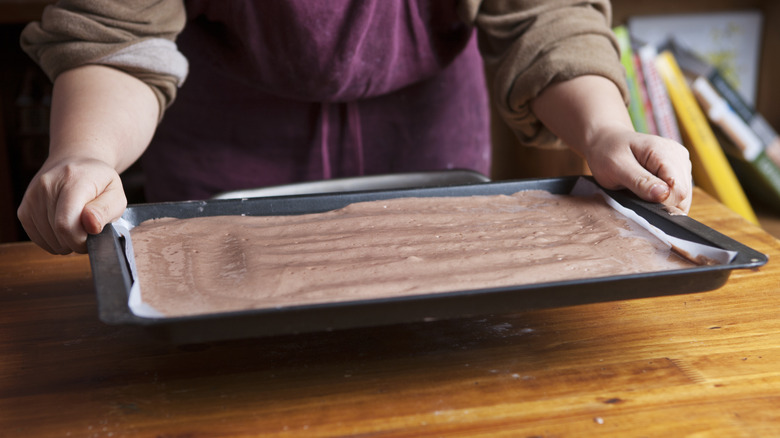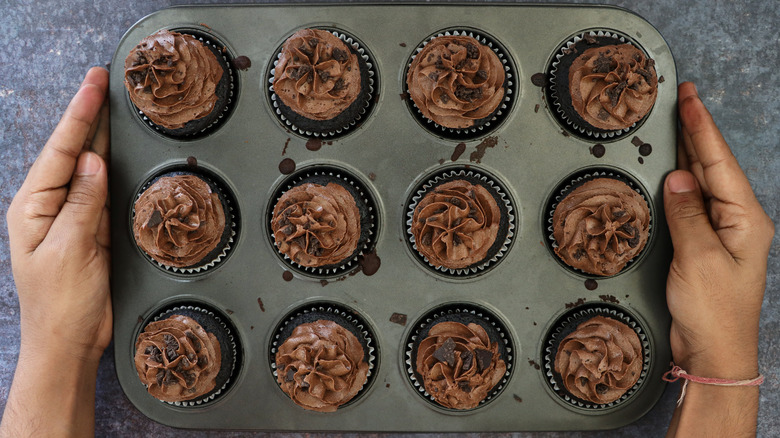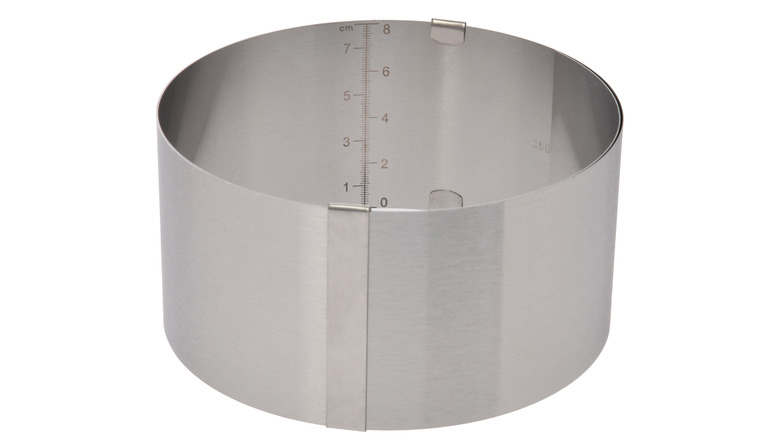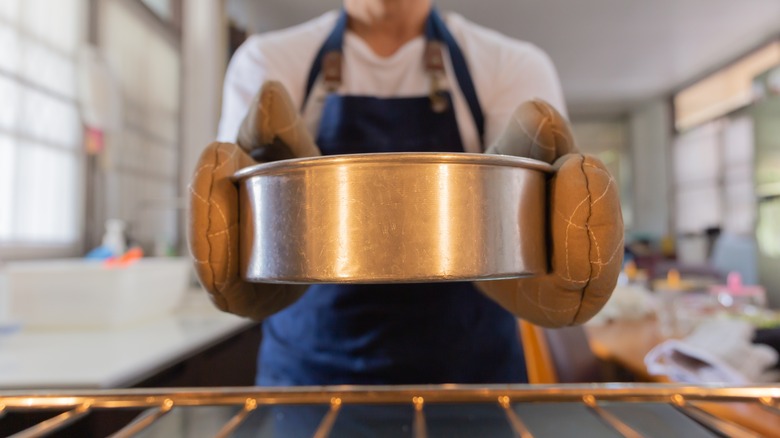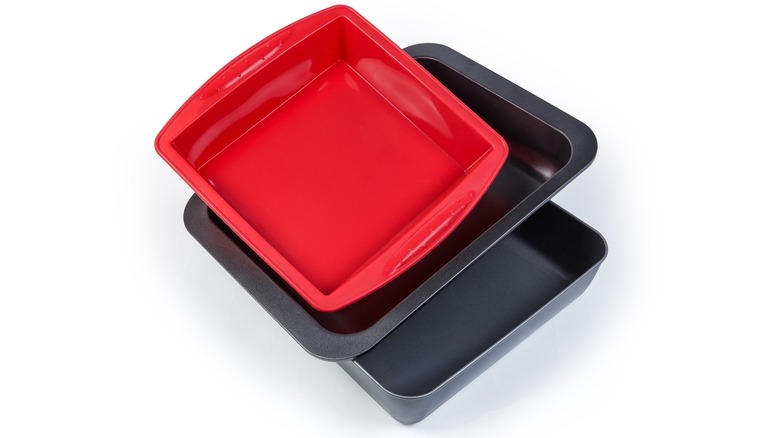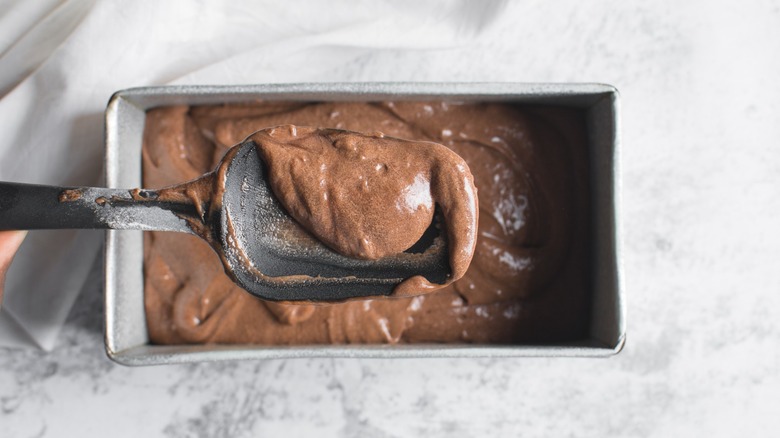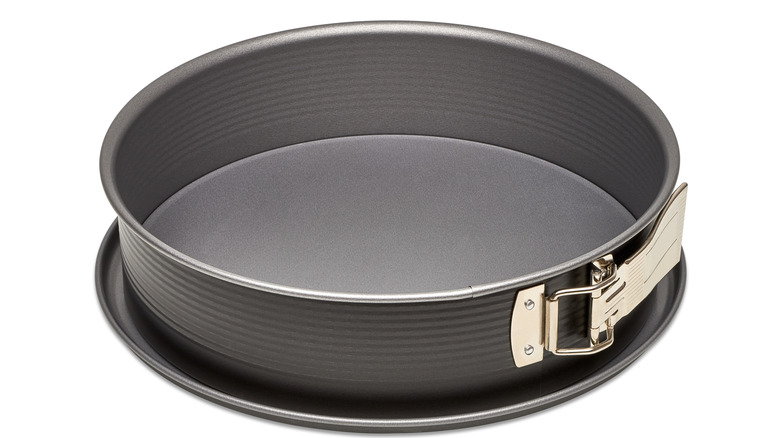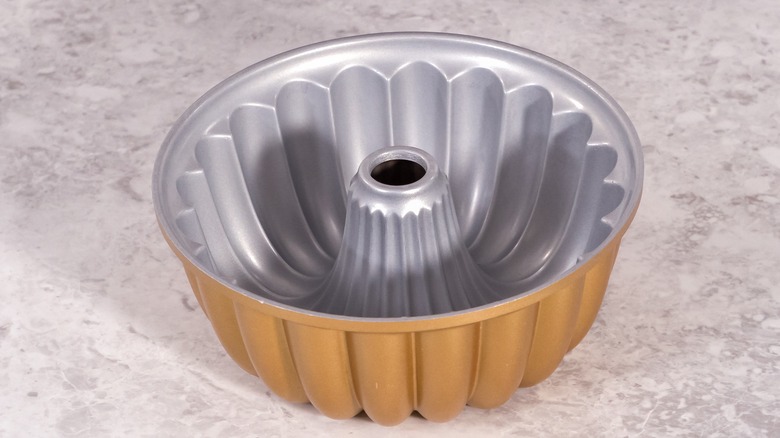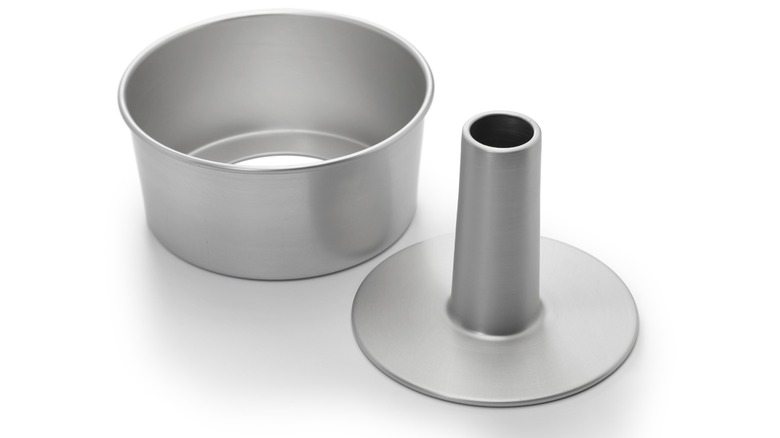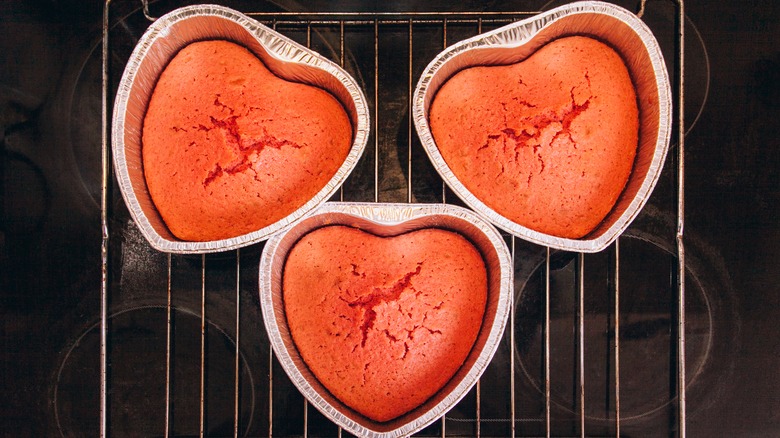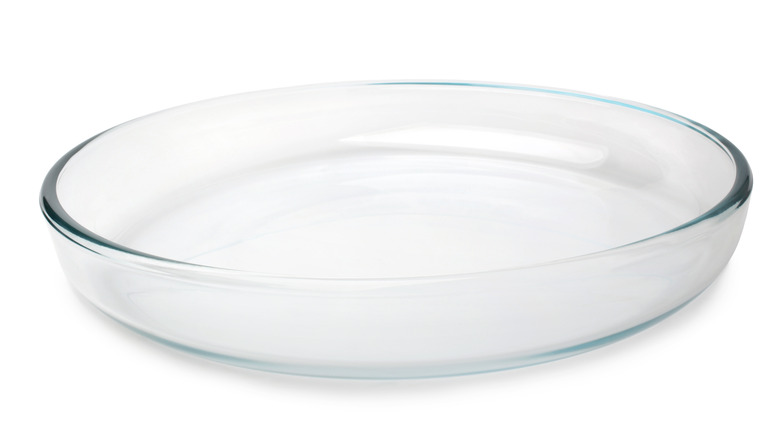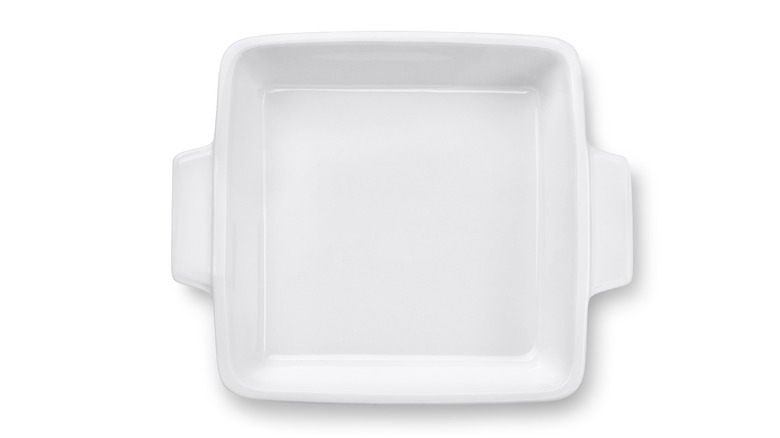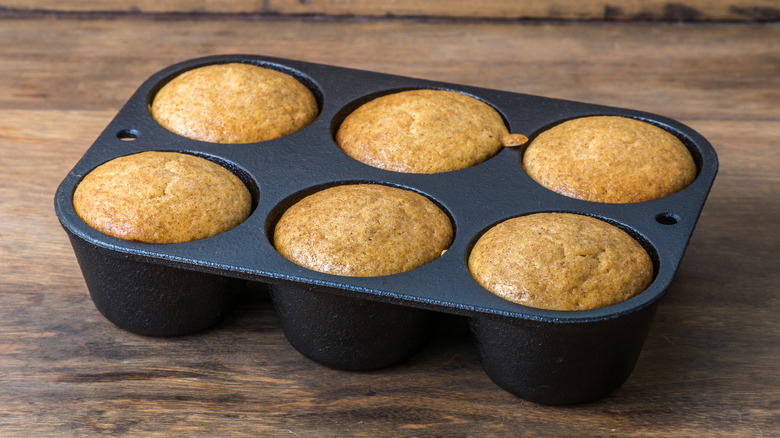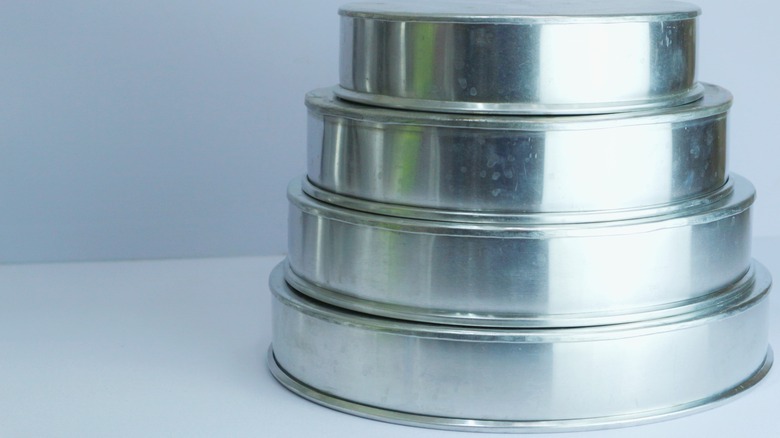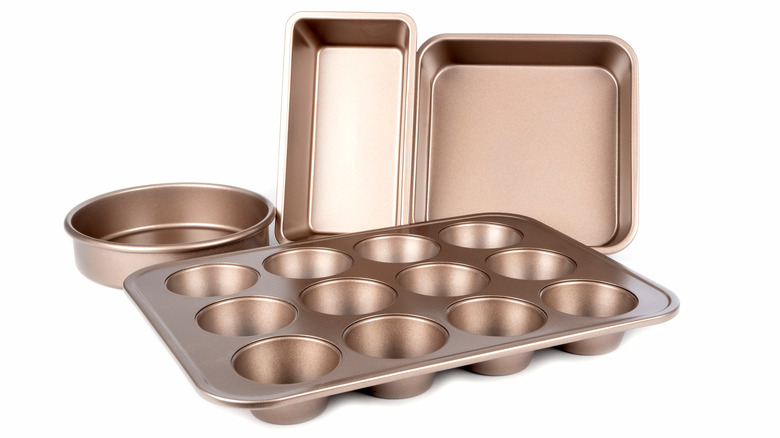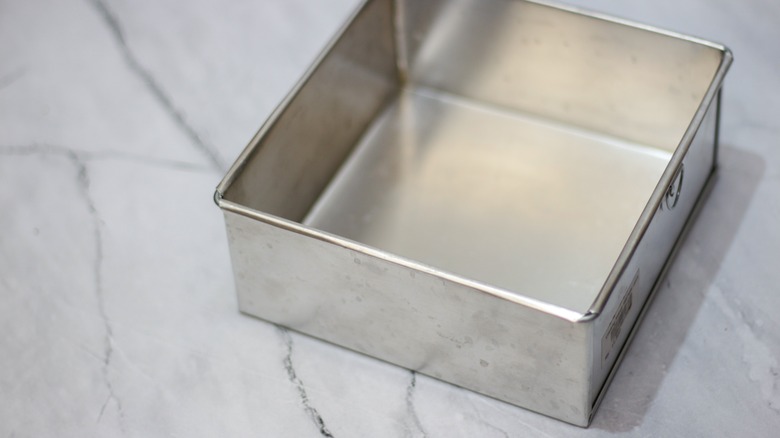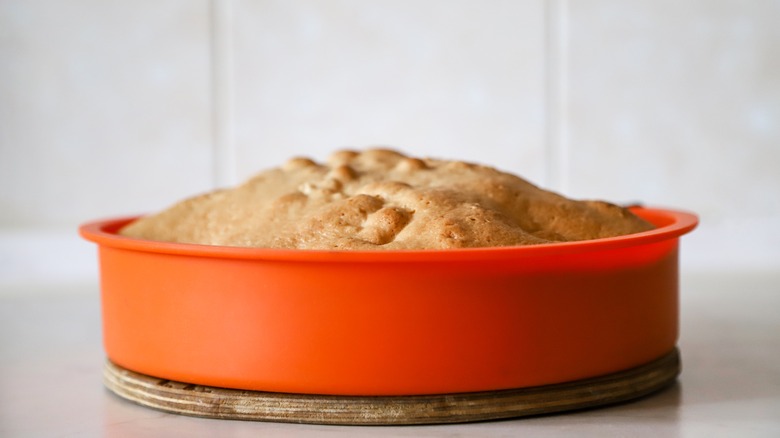How Different Types Of Pans Affect Your Cakes
You've likely heard how baking is a science. It requires specific measurements of ingredients, which react to one another to create incredible goodies like breads and pastries. However, there's another aspect that many people overlook: How certain types of bakeware can impact the final baked goods, particularly cakes. Not all cake pans are created equal, and different batters may require specific pans. The pan's shape, depth, and material all play a crucial role in determining how the cake rises and turns out. Before you work with a particular pan, it's wise to know some background on it. Don't worry, though; I can help you out with this.
I've made all sorts of cakes, from my home baking days to obtaining my baking and pastry degree and years of working in commercial kitchens. In other words, I've learned some of this information the hard way, so you don't have to. Whether you want to make a breathtaking Bundt cake or a tiered sheet cake, this guide can steer you on the right path, so you can be prepared for how your cake batter will react to a specific type of bakeware. First, I'll cover different pan shapes. Further down the article, I'll discuss how the pan materials come into play, too.
Sheet pans
Although sheet pans (also known as baking sheets) are for cooking all sorts of treats, you can use them to make quarter-sheet, half-sheet, or full-sheet cakes. These pans come in various materials, such as stainless steel and aluminum. Their lengths and widths vary, but they are usually 1 inch tall.
Sheet pans differ from cookie sheets. They have rims around every side to contain batter, helping you to make thin, flat cakes that you can stack to create layers. When using these pans, your cakes often bake quicker since the batter is spread out thinner than, say, a Bundt pan or loaf pan (this also means they cool quicker, too). The benefit is that they promote even baking since the edges and center are exposed to the heat more directly. You don't get much doming with these pans, either.
Jelly roll pans
Some might confuse jelly roll and sheet cake pans since they look similar at first glance. Both pans are shallow and rectangular. However, the primary feature that sets them apart is their size. Jelly roll pans are in between standard sheet pan sizes. They have the same 1-inch rims because you need a super thin cake to make a successful jelly roll, but they are larger than a quarter-sheet and smaller than a half-sheet.
Also, some versions have special textures on the pan base, which is a purposeful design. Adding tiny grooves to the pan gives the batter less direct surface contact in certain areas. As a result, those gaps allow airflow, resulting in a consistent rise. Since the cakes come out evenly baked, you can effortlessly release them from the pan, and they don't break when you roll them with fillings like mousse or jam.
Muffin (cupcake) pans
Muffin and cupcake pans are the same thing. They are available in numerous materials (silicone, aluminum, ceramic) and sizes (6,12, or 24 muffin capacity). In the standard type, each cup holds up to ⅓ cup of batter. Suppose you decide to use a cupcake pan rather than a standard round pan. In that case, you should either follow the cupcake recipe directions or significantly reduce the baking time, as they bake much faster than regular-sized cakes.
Depending on the material and your muffin pan size, you might want to consider setting it on a sheet pan in the oven. Otherwise, the pan might wobble or be challenging to remove. Also, when cooling cupcakes, remove them from the pan as soon as they are cool enough to touch without burning yourself. If you leave them to cool in the pan, they can trap steam underneath, causing soggy bottoms.
Cake rings
Cake rings are unique because they don't have a bottom. Although you can use them to assemble immaculate layer cakes, you can also use them as baking vessels. Since they don't have a base, though, you must prepare the pan differently. You can use foil as the bottom, wrapping it around the edges to prevent the batter from leaking.
Another option is placing the cake ring directly on a flat sheet pan lined with parchment paper. Unfortunately, if the batter is too thin or the pan is warped, it will leak, so you need to be careful with this method. Nevertheless, these rings are advantageous because they give cakes a uniform, pristine look with straight sides and easy removal since you just have to lift the ring to release the baked cake.
Round pans
Round cake pans are a popular choice when it comes to baking. These pans are available in a range of sizes from 4 to 12 inches or larger. Most commonly, they're metal, although companies use other materials to manufacture them, too. Straight-sided round pans are perfect for making cakes that you can layer or carve.
However, beware if you plan to make a layer cake with a pan that has slanted sides — they make your cakes slightly larger in diameter on the top. Depending on your cake, it might shrink and even out when it cools, but not always. If that happens, you must trim the edges to make the sides straight for stacking. Round pans can also cause some pretty heavy doming on top. There are ways around this, such as using moistened cake strips around the edges or a lower oven temperature.
Rectangular and square cake pans
These pans are popular among bakers, too. Their basic form provides flexibility for simple or elaborate designs, as you can easily sculpt the cake to create different shapes. Some rectangular ones are the same size as sheet pans. For example, 9 x 13 inches is a quarter sheet size. However, they are much deeper, as they can be 2 to 4 inches tall. They're also available in different lengths, which may not correspond to the standard sheet pan sizes.
Concerning square options, these can range from 4 to 18 inches. When you use rectangular or square pans, be cautious of the cake corners as they tend to burn or overcook. This issue is more apparent than in round pans since the corners have thinner edges. To avoid this, use a spatula and be sure to push enough batter into the corners.
Loaf pans
Loaf pans are rectangular, and their standard size is 8 ½ x 4 ½ x 2 ½ inches, but you can also find larger ones. They're available in different materials, such as metal, silicone, or glass. Although you might think you can only make foods like banana bread or meatloaf with them, you can also make cakes.
In my professional experience, I've seen how using loaf pans in the wrong circumstances can negatively impact the texture of specific cakes or prevent them from turning out altogether. This is because their unique shape can cause uneven baking, so it's crucial only to use them when a recipe specifically calls for them, such as with dense batters like buttery pound cakes that you can bake at a moderate temperature. Moreover, loaf pans might cause cracks on the surface of your cake, but in some instances, this is actually part of the desired aesthetic.
Springform pans
This might be news, but springform pans are not exclusively for cheesecakes. You can use them to bake regular cakes too! These pans come in two parts, the base and walls, which you can secure with a latch. Springforms are generally round, and you can find them in various sizes, with 7 to 9-inch pans being customary. They allow you to easily unmold delicate baked goods without damaging them.
Not only does this design preserve the cake's overall quality by preventing it from breaking, but the sides come out perfectly straight, too. Because of their purpose, it makes sense why most are metal, although some with softer materials are out there. When making a cake in this pan, you might run into an issue if your batter is super thin, as it can run through the cracks. However, you can prevent this by lining the pan with foil.
Bundt pans
You're not alone if you're confused about the difference between a tube pan and a Bundt pan. They are very similar, after all. A Bundt pan is technically a type of tube pan. But it deserves its own spot on the list because it's different in a few ways: It holds less volume, has grooves in its design, and doesn't have a detachable side or bottom.
When you make a cake in a Bundt pan, there are some things to know. First, not every type of cake batter is welcome. These pans require heavier batter, because lightweight cakes can easily break when you release them from the intricately designed bakeware. This leads to the next point: Bundt pans can make cakes stick. It's vital to properly grease the pan before using it, especially since you can't line it with parchment due to its design.
Tube (angel food cake) pans
Most tube pans have a detachable bottom for straightforward unmolding. Unlike Bundt pans, they don't have a unique rounded shape with waves but have tall and straight sides. Bakers use these for fragile batters that rise considerably, like chiffon cake or angel food cake. Putting one of these batters into a greased tube pan won't achieve the desired lift. Instead, an ungreased pan is a must.
Airy cakes are ideal with tube pans because the batter can adhere to the tall sides and climb, creating an impressive height. The tube is there because, without a center, the cake is more stable and heats more uniformly. These pans hold more batter than Bundt pans; they're usually 8, 9, or 10 inches in diameter and 3 inches in height, so if you try to bake a dense cake, it might not cook all the way through.
Novelty cake pans
Stars, animals, hearts, cartoon characters, and 3D pans are all examples of novelty pans. Although you can create extraordinary cakes with this type of bakeware, they can be tricky to work with. Depending on the exact shape and depth, the cake might bake unevenly if you aren't careful.
You can't use just any cake mix in one of these pans. You might also need to adjust the oven temperature and baking time. Novelty pans may also require heating rods in some instances, which are metal rods you place in the center of the pan while the cake bakes to improve heat distribution. It's best to refer to the bakeware manufacturer's guidelines so you can properly prepare the pan and ensure the cake bakes correctly.
Glass cake pans
Despite their popularity, it's a good idea to avoid glass pans when you make cakes. First of all, their heat conduction is poor. If you're unsure of what that means, it takes quite a while for the pan to heat and for the cake to start cooking once it's in the oven. In turn, the cake might cave in on itself since it bakes more slowly. As a solution, you can increase the baking time for it to properly cook, though the presentation might suffer.
Once you're done baking, the heat also stays longer than needed. Consequently, you might end up with an overbaked or dry dessert because of the carryover cooking. Glass pans can also cause over-browning on the cake's exterior, especially the areas directly in contact with the bakeware. You can manage this issue by slightly lowering your oven temperature by around 25 degrees Fahrenheit.
Ceramic
Ceramic and glass pans are different, even though their glossy finishes can make them seem similar. Companies make this type of bakeware with clay and earth minerals. Two well-known kinds of ceramic pans are stoneware and porcelain pans. It's essential to check the manufacturer's recommendations when using ceramic pans because they might have temperature restrictions — not all can withstand high heat.
In my experience working with ceramic bakeware, the thermal conduction rate depends on the brand and the exact minerals it contains, so you have to test out your pans to see how they affect the cakes. Generally though, these dishes, like glass, take a while to heat in the oven and then hold onto that heat, which can cause cakes to be super dark in color. Again, you might want to start with a lower oven temperature to be safe.
Cast iron
Cast iron is a heavy-duty alloy containing iron and carbon. Undoubtedly, cooking with cast iron is great and helps you make some spectacular steak, but how does it hold up in baking? Well, these pans have their pros and cons. First, when baking with cast iron, the use of flour is important. You should lightly grease and flour the pan before making the cakes you plan to unmold. Otherwise, they might stick (yes, they're not always non-stick). But once you get past that part, the benefits of cast iron are clear.
I've seen firsthand with this bakeware how cakes cook evenly throughout and don't form domed tops. This is because the pans are pretty thick. They distribute heat more evenly, preventing scorching and providing a gentler touch to the cake batter. There's a catch, though: For even baking and browning, you must preheat the pan before using it.
Stainless steel
Stainless steel is a fusion of chromium and steel. The benefits? These pans can last a long time and don't rust, making them extremely durable. Still, they're less efficient at transferring heat than other metals. When compared to glass, though, their thermal conduction is better, so they fall somewhere in the middle.
When you work with this bakeware, it might make your cakes stick if you don't properly prepare the pans. It's crucial to grease and flour them (or line them with parchment paper) so you can release the cakes without any trouble. Moreover, these pans can be inconsistent regarding the appearance of your cake; hot spots can make certain areas of the cake cook or brown faster than other parts.
Carbon steel
Carbon steel includes a mixture of multiple materials, like carbon and iron, including other alloy metals, giving it a different composition than stainless steel. Due to its unique makeup, carbon steel is better at transferring heat. These pans are advantageous because their temperature rises faster than cast iron, eliminating the need for preheating. They also cool down swiftly, so the cakes don't continue cooking for long after leaving the oven. Additionally, they have non-stick properties.
One major downside to this material type is that it rusts easily if you don't care for it. Also, since the metal becomes darker the more you use it, it can make the cakes cook faster and have more color than you want. To avoid this, you can lower the oven temperature by 25 degrees Fahrenheit.
Aluminum
Here's another type of metal: Aluminum, a soft metal. If you've ever worked with aluminum, you've likely noticed how lightweight it is, especially compared to cast iron. One of the characteristics that makes it appealing is how well it transmits heat. When you pop your cake in the oven, it instantly goes to baking. It's also light in color, reflecting the heat instead of absorbing it, so you don't need to worry about your cakes becoming too dark.
I've made plenty of sheet cakes in aluminum pans, and they bake up quite nicely without needing to adjust the time or temperature. However, one downside of aluminum is that it can make cakes stick if you don't prepare the pan well enough.
Silicone
Silicone bakeware is much softer than the others listed. Companies make these pans with a synthetic polymer, which isn't plastic or rubber but feels similar to them. These molds are popular among bakers due to their flexibility. You can easily bend silicone pans to unmold cupcakes or to store them more easily. Additionally, they're lightweight, which is another reason why storing them is more convenient than hard pans.
These molds do have some downsides, however. First, I've noticed a few things when professionally working with them throughout the years. Cakes can be either dense or gummy when using this bakeware. You also don't receive as much browning as you do with other pans, so often, your bakes might look pale. Lastly, despite the consensus that silicone is non-stick and easy to release, that's not always the case, so you should probably spray it to be safe.
